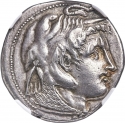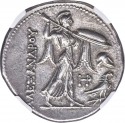You are about to finish your registration. Please check your mailbox (including spam folder). There should be a letter with a confirmation link. Check setting to make sure that your e-mail address is correct.
Send letter again
Obverse

|
The portrait in right profile of Alexander the Great is surrounded with the legend "Alexander the Great King of the Macedons". ΜΕΓΑΣ ΑΛΕΞΑΝΔΡΟΣ |
|---|---|
Reverse

|
A sixteen rays Vergina Sun is surrounded with the facial value and the inscription "Republic of Greece". ΕΛΛΗΝΙΚΗ ΔΗΜΟΚΡΑΤΙΑ |
| Edge |



